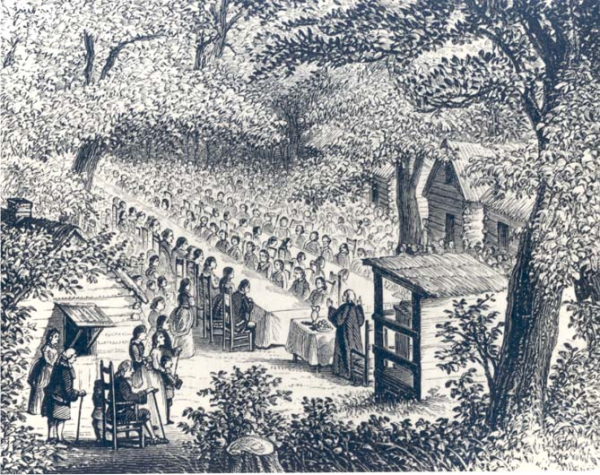How James McGready
Relates to
the
Heresy of
Decisional Regeneration

James McGready (1758-1817) is considered the father of the American Camp Meeting. Actually, he merely continued a tradition of Presbyterian Sacramental Meetings that had been held in Scotland since the seventeenth century and that were brought to the American Colonies by Presbyterians and celebrated in America since the eighteenth century. These were held annually and sometimes bi-annualy, sometimes called "holy fairs". The events were structured to achieve maximum evangelistic results. Participants were exhorted to examine themselves over a period of days culminating in the sharing of the Lord's Supper. The restoration of regenerate believers was emphasized as much as the regeneration and conversion of unbelievers. This should help modern readers understand the psychological pressures on participants to conform to holiness standards in order to qualify to receive a Communion Token to be admitted to the Lord's Table. All the customs from Scotland were maintained in the American Sacramental Meetings. The fencing of the tables, Communion Tokens, Scottish Psalm Singing, Preparatory Meetings, Fast Days, Thanksgiving Services, Action Sermons, sitting at the long linen-covered tables, the great crowds, outdoor preaching from the tent, all were part of the psychological buildup and release of emotion of what we call the Camp Meeting. As a young man in the late 1700's, McGready experienced the Presbyterian Sacramental Meeting revivals in Pennsylvania. The Sacramental Meeting normally included a Thursday Fast, a Saturday Preparation Service and the Lord's Supper that began Sunday Morning and could last the entire day, and the Monday Thanksgiving Service. The intention of the Meeting was two-fold: 1) Evangelistic proclamation of the Gospel to unbelievers who may be quickened by the Holy Spirit , experience regeneration and conversion and then be able to partake of the Lord's Supper, and 2) the restoration of regenerate believers. Repentance, renewal and release was the goal to be reached with prayer and fasting, self-examination, action sermons, public exhortation and counselling, and if a person savingly repented, the Lord's Supper and thanksgiving. McGready's Action Sermons exhorted, convicted, cajoled, and prepared people to experience Christ in the Lord's Supper. This should help the reader understand that McGready was not merely looking for conversion...he was preaching for a sacramental experience, something ignored in almost all histories of the American Camp Meetings because of the revisionist histories written by Scottish Common Sense Realists who no longer believed in the immediate activity of the Holy Spirit and limited the Holy Spirit to quickening "truth impressions" to the mind according to the "verbal restrictive" theory. McGready was taught Scottish Common Sense Realism under a College of New Jersey graduate named John McMillan. Shortly after taking up his studies, McGready fell under a siege of smallpox and faced the question of his eternal destiny. He wrestled with it, and on the first Sunday after his recovery from smallpox, he was converted. His zeal for revival may have been kindled during a visit to Hampden-Sydney College in Virginia run by Scottish Common Sense educated John Blair Smith (1756-1799). In 1788, when "about 30 years of age," he was licensed to preach in the presbytery of Redstone, in western Pennsylvania. Returning to North Carolina, McGready preached the wrath of God so vigorously that he ignited revival fires which drove penitents to faith in Jesus. One of these was Barton W. Stone, who later led the famous Cane Ridge camp meeting in Kentucky. He took up his new challenge in the southwestern corner of Kentucky, preaching to three small congregations at Red River, Gasper River and Muddy River. All three were in Logan County, notorious for its lawlessness. Surprisingly, however, the backwoodsmen responded enthusiastically to McGready's vivid preaching. In July 1800 McGready helped shape the course of American history. After an original revival at Red River, he decided to send out advance notice of the next Sacramental Meeting at the Gasper River church. When the word spread through the settlements, scores of pioneers headed in wagons and on horseback for Gasper River, expecting to witness the work of God. They came from as far away as 100 miles, prepared to stay several days. This was the first of many Sacramental Meetings. To read a first-hand account of the amazing events connected to the sacramental meetings, read Lyle's Diary. |